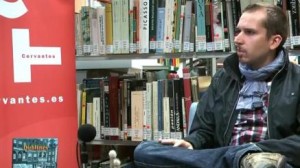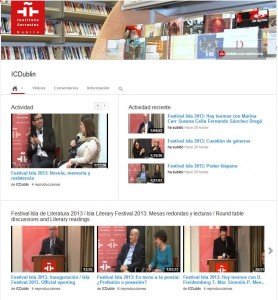Blog del Instituto Cervantes de Dublín
Torre Martello
Interview with Alfonso Zapico
Alfonso Zapico: I am very serious-minded compared to Joyce
Interview with Alfonso Zapico held on 16th June, 2011 at the Dámaso Alonso Library of the Instituto Cervantes in Dublin on the occasion of the presentation of his book Dublinés at the Irish Writers’ Centre in Dublin.
Alfonso Zapico (Blimea, Asturias, 1981) is a cartoonist and illustrator. He studied Illustration and Design at the School of Art in Oviedo and contributes regularly to various periodicals and publishers. His first professional work in the world of comics was published in France: La guerre du professeur Bertenev (2006), set during the Crimean War, and the collective volume Un jour de mai (2007). In 2008 he published Café Budapest, addressing the Arab-Israeli conflict. In 2009 he participated in another collective volume: Un buen hombre, on the daily life of SS officers. For his most recent work, Dublinés (2011), a biography of James Joyce, he received a residency at La Maison des Auteurs in Angoulême (France), and the Premio Nacional prize for comic books in 2012.
Carmen Sanjulián: —Alfonso, you’re a cartoonist, you do graphic novels… How do you prefer to be called?
Alfonso Zapico: —I call myself simply an illustrator or cartoonist. Then I write books, comics, stories which can be labelled in different ways depending on how you want to call them, but they are basically stories.
Carmen Sanjulián: —From Café Budapest to Dublinés only two years went by. What happened in that time?
Alfonso Zapico: —Well, I was looking for another story to tell. I didn’t really know what to do and then this biography of Joyce appeared. At first it was like a challenge, something new, and I didn’t know how it would end up. The publisher didn’t have much confidence in it but finally it has resulted in more than two years of work, travel and also changes. Besides, as this is also a travel book it has been a way of evolving for me, to some extent, a way of drawing all this.
Carmen Sanjulián: —What fascinated you about Joyce to the point that you wanted to make a book about him?
Alfonso Zapico: —When I started to draw Dublinés I didn’t know much about the author, I’m not an expert in literature. But, I don’t know why there is something about Joyce that grips you, that attracts your attention, that gives you the urge to find out about him. And that’s what inspired me to start Dublinés. In the end, I depicted the “surface” of this author, with his optimistic philosophy of life and his love for every detail… at the same time I was telling the real story of a guy full of contradictions, of course.
Carmen Sanjulián: —Do you also slide down the handrails like Joyce used to do after class?
Alfonso Zapico: —Not at all. I am very serious-minded compared to Joyce.
Carmen Sanjulián: —Do you think the entire story would be more interesting if it were told the same way as your biography of Joyce?
Alfonso Zapico: —I think so. At first, Joyce’s story or his literature may seem quite abstract, let’s say very distant, complicated. But the advantage of the graphic novel is that the strips induce the reader to soak up the story very fast and they create a certain complicity because the reader becomes the travelling companion of the protagonist and travels along the pages, goes around the cities together with the character, becomes part of his life until the end.
Carmen Sanjulián: —What comes first, the story or the drawings?
Alfonso Zapico: —For me, the story. Then I draw the strips with the story in mind. I’ve used grey colours for Dublinés, a realistic drawing style, because that’s what the story required. For Café Budapest, which is more of a caricature, I used black and white, which was more suitable for the story.
Carmen Sanjulián: —Which comics did you read in your childhood?
Alfonso Zapico: —The ones everybody else used to read: Tintin, Spirou, Asterix, Mortadelo y Filemón, Zipi y Zape… In short, I was a conventional comic reader. I devoured them all, those available at the library and others I found lying around.
Carmen Sanjulián: —Do you still read comics?
Alfonso Zapico: —I do. The thing is that as the comic sector has changed so much, there are so many new publications, the graphic novel, many foreign authors… The truth is that I don’t know much, now I’m starting to know more and read more comics. But paradoxically, being a comic author myself, I didn’t know much.
Carmen Sanjulián: —Tell us a secret: Have you dazzled many girls with your drawings?
Alfonso Zapico: —To be honest, I don’t think so. I don’t have the aura of the bohemian painters.
Carmen Sanjulián: —Do you take photographs?
Alfonso Zapico: —I don’t. I only took photos when I studied photography at the School of Arts and I wasn’t very skilled.
Carmen Sanjulián: —Asturias, beloved homeland… What can you say about Asturias?
Alfonso Zapico: —I live in France now and I haven’t been to Asturias in a long time. I really miss it. But coming to Dublin has made me feel a bit better because it’s pretty similar, you know. Because of the weather, the many pubs, the people talking very loud. I can feel the difference with respect to France.
Carmen Sanjulián: —Is there any difference between Asturias and Ireland?
Alfonso Zapico: —Yes, there are differences. I don’t know Ireland. For me, Asturias is special.
Carmen Sanjulián: —You write a blog with illustrations. Do you think the future of the comic, as with many other things, will be the Internet? Will we say good-bye to paper?
Alfonso Zapico: —I think the future of the comic will be the Internet. However, I don’t think paper will disappear. I think it will happen the same way as with novels, and books. The electronic comic is already a reality and I think it will do well. But I think that paper comics with a hard cover, or hardback, will continue to be published and sold.
Carmen Sanjulián: —Do you have any other historical figure in the pipeline?
Alfonso Zapico: —Not for the moment. I’ve been working on this comic for a long time and I have other things to finish. I haven’t figured out yet what I’m going to do next.
Carmen Sanjulián: —Today is June 16th, Bloomsday. What does it mean to you to present your book Dublinés on such a special day and, on top of that, in Ireland, in Dublin?
Alfonso Zapico: —It’s quite quaint. If I had been told that this would happen when I started drawing this book, I wouldn’t have believed it. But look, I was lucky that the book was finished this year, it was published in May and here I am, on June 16th, the same day Joyce went for a walk with Nora, along the strand. So it’s a great ending.
Carmen Sanjulián: —Do you see life in cartoon strips?
Alfonso Zapico: —I do. I jot down things and retain faces and details that I use later as fuel for my drawings.
Recommended links
- [Video] Interview with Alfonso Zapico at the Instituto Cervantes in Dublin by Carmen Sanjulián.
- Alfonso Zapico’s website.
- Zapiburgo Telegraph. Alfonso Zapico’s blog.
- Alfonzo Zapico in Astiberri Publishing House..




